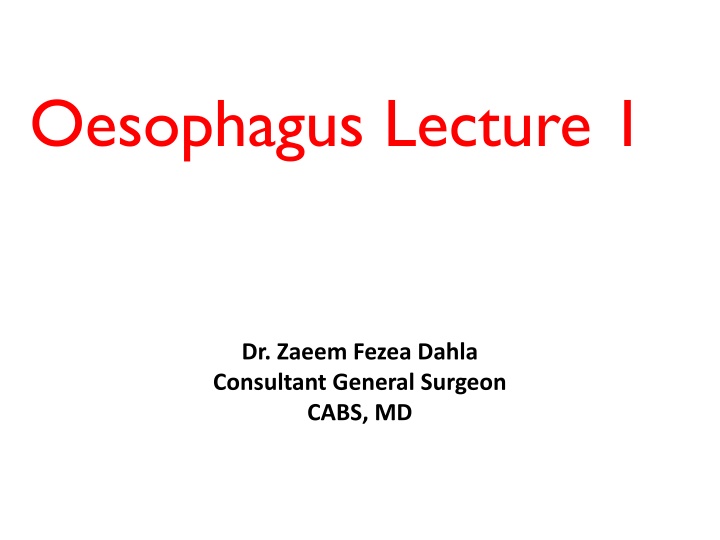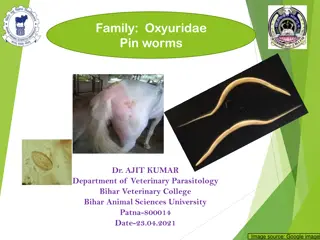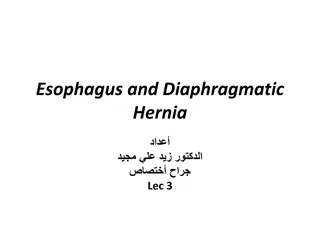Oesophagus Lecture 1
This presentation covers the surgical anatomy, symptoms, investigations, and management of oesophageal diseases. Learn about the anatomy of the oesophagus, common symptoms like dysphagia and heartburn, diagnostic investigations including radiography and CT scans, and the main learning objectives related to this topic. Gain insights into the muscular structure of the oesophagus, the role of striated and smooth muscles, and the key clinical manifestations of oesophageal disorders.
Download Presentation

Please find below an Image/Link to download the presentation.
The content on the website is provided AS IS for your information and personal use only. It may not be sold, licensed, or shared on other websites without obtaining consent from the author.If you encounter any issues during the download, it is possible that the publisher has removed the file from their server.
You are allowed to download the files provided on this website for personal or commercial use, subject to the condition that they are used lawfully. All files are the property of their respective owners.
The content on the website is provided AS IS for your information and personal use only. It may not be sold, licensed, or shared on other websites without obtaining consent from the author.
E N D
Presentation Transcript
Oesophagus Lecture 1 Dr. Zaeem Fezea Dahla Consultant General Surgeon CABS, MD
LEARNING OBJECTIVES The anatomy and physiology of the oesophagus The main Investigations used in oesophageal diseases. Management of certain conditions like foreign body, perforation.
Surgical anatomy The oesophagus is a muscular tube, approximately 25 cm long. mainly occupying the posterior mediastinum and extending from the upper oesophageal sphincter (the cricopharyngeus muscle) in the neck to the junction with the cardia of the stomach. The musculature of the upper oesophagus, including the upper sphincter, is striated. The upper half of both striated and smooth muscle.
Surgical anatomy The lower half of the oesophagus, there is only smooth muscle. The lower sphincter is more subtle, and is created by the asymmetrical arrangement of muscle fibres in the distal oesophageal wall just above the oesophagogastric junction. It is helpful to remember the distances 15, 25 and 40 cm for anatomical location during endoscopy
Symptoms of oesophageal diseases Difficulty in swallowing described as food or fluid sticking (oesophageal dysphagia) must rule out malignancy Pain on swallowing (odynophagia) suggests inflammation and ulceration Regurgitation or reflux (heartburn) common in gastro-oesophageal reflux disease Chest pain is difficult to distinguish from cardiac pain
Investigations used in the oesophageal diseases Radiography: Plain radiographs will show some foreign bodies. Contrast radiography useful investigation for demonstrating narrowing, space-occupying lesions, anatomical distortion or abnormal motility. however, it is inaccurate in the diagnosis of gastro-oesophageal reflux. computed tomography (CT) scanning is now an essential investigation in the assessment of neoplasms of the oesophagus and can be used in place of a contrast swallow to demonstrate perforation.
Investigations used in the oesophageal diseases Endoscopy: Endoscopy is necessary for the investigation of most oesophageal conditions, namely: to obtain a biopsy or cytology specimen. for removal of foreign bodies. to dilate strictures. Traditionally, there are two types of instrument available, the rigid oesophagoscope and the flexible video endoscope. the rigid instrument is now virtually obsolete.
Investigations used in the oesophageal diseases Endosonography: Endoscopic ultrasonography relies on a high-frequency (5 30 MHz) transducer located at the tip of the endoscope to provide highly detailed images of the layers of the oesophageal wall and mediastinal structures close to the oesophagus. Two types: Radial and linear echoendoscopes:
Investigations used in the oesophageal diseases Oesophageal manometry: Widely used to diagnose oesophageal motility disorders. Recordings are usually made by passing a multilumen catheter with three to eight recording orifices at different levels down the oesophagus and into the stomach. Important tool in the treatment of reflux diseases.
Investigations used in the oesophageal diseases Twenty-four hour pH and combined pH-impedance recording: Prolonged measurement of pH is now the most accurate method for the diagnosis of gastro-oesophageal reflux. It is particularly useful in patients with atypical reflux symptoms, those without endoscopic oesophagitis and when patients respond poorly to intensive medical therapy.
FOREIGN BODIES IN THE OESOPHAGUS Button batteries may be a troublesome problem in children. The most common impacted material is food. which usually signifies underlying disease Plain radiographs are often useful for foreign bodies, but modern denture materials are not always radiopaque. It is usually possible to remove foreign bodies by flexible endoscopy False teeth impacted in the oesophagus can be radioapaque, however , modern dentures are usually radiolucent.
Oesophageal perforation Perforation of the oesophagus is usually iatrogenic during instrumentation (at therapeutic endoscopy) or due to barotrauma (spontaneous perforation). Many instrumental perforations can be managed conservatively, but spontaneous perforation is often a life-threatening condition that regularly requires surgical intervention. Potentially lethal complication due to mediastinitis and septic shock Surgical emphysema is virtually pathognomonic.
Barotrauma (spontaneous perforation, Boerhaave syndrome) This occurs classically when a person vomits against a closed glottis. The pressure in the oesophagus increases rapidly, and the oesophagus bursts at its weakest point in the lower third, sending a stream of material into the mediastinum and often the pleural cavity as well. Boerhaave syndrome is the most serious type of perforation because of the large volume of material that is released under pressure. Barotrauma has also been described in relation to other pressure events when the patient strains against a closed glottis (e.g. defaecation, labour, weight-lifting).
Diagnosis of spontaneous perforation Diagnosis of spontaneous perforation The clinical history is usually of severe pain in the chest or upper abdomen following a meal or a bout of drinking. Associated shortness of breath is common. Many cases are misdiagnosed as myocardial infarction, perforated peptic ulcer or pancreatitis if the pain is confined to the upper abdomen. There may be a surprising amount of rigidity on examination of the upper abdomen, even in the absence of any peritoneal contamination.
The diagnosis can usually be suspected from the history and associated clinical features. Achest x-ray is often confirmatory with air in the mediastinum, pleura or peritoneum. Pleural effusion occurs rapidly either as a result of free communication with the pleural space or as a reaction to adjacent inflammation in the mediastinum. Acontrast swallow or CT is nearly always required to guide management.
Computed tomography scan showing the site of perforation in the lower oesophagus.
Pathological Pathologicalperforation perforationof of oesophagus oesophagus Free perforation of ulcers or tumours of the oesophagus into the pleural space is rare. Erosion into an adjacent structure with fistula formation is more common. Covering the communication with a self-expanding metal stent is the usual solution.
Perforation induced by Foreign body The oesophagus may be perforated during removal of a foreign body. Usually the object has been left in the oesophagus for several days will erode through the wall.
Instrumentational perforation Prevention of perforation is better than cure. Perforation related to diagnostic upper gastrointestinal endoscopy is unusual with an estimated frequency of about 1:4000 examinations. Perforation can occur in the pharynx or oesophagus, usually at sites of pathology or when the endoscope is passed blindly. Perforation may follow biopsy of a malignant tumour.
Patients undergoing therapeutic endoscopy have a perforation risk that is at least ten times greater than those undergoing diagnostic endoscopy. The oesophagus may be perforated by guidewires, graduated dilators or balloons, or during the placement of self-expanding stents. The risk is considerably higher in patients with malignancy.
CLINICAL FINDINGS: Cervical perforation may result in pain localised to the neck, hoarseness, painful neck movements and subcutaneous emphysema. Intrathoracic and intra-abdominal perforations, which are more common, can give rise to immediate symptoms and signs either during or at the end of the procedure, including chest pain, haemodynamic instability, oxygen desaturation or visual evidence of perforation. Within the first 24 hours, patients may additionally complain of abdominal pain or respiratory difficulties.
CLINICAL CLINICALFINDINGS: FINDINGS: There may be evidence of subcutaneous emphysema, pneumothorax or hydropneumothorax. In some patients, the diagnosis may be missed and recognised only at a late stage beyond 24 hours, as unexplained pyrexia, systemic sepsis or the development of a clinical fistula. Prompt and thorough investigation is the key to management. Careful endoscopic assessment at the end of any procedure combined with a chest x-ray will identify many cases of perforation immediately.
CLINICALFINDINGS: If not recognised immediately, then early and late suspected perforations should be assessed by a water-soluble contrast swallow. If this is negative, a dilute barium swallow should be considered. CT scan can be used to replace a contrast swallow or as an adjunct to accurately delineate specific fluid collections.
Treatment of oesophageal perforations: Perforation of the oesophagus usually leads to mediastinitis The loose areolar tissues of the posterior mediastinum allow a rapid spread of gastrointestinal contents. The aim of treatment is to limit mediastinal contamination and prevent or deal with infection. Both operative and non operative approach have it is own advantages and risks
The decision between operative and non-operative management rests on four factors. These are: 1-the site of the perforation (cervical versus thoracoabdominal oesophagus). 2-the event causing the perforation (spontaneous versus instrumental). 3 -underlying pathology (benign or malignant). 4-the status of the oesophagus before the perforation (fasted and empty versus obstructed with a stagnant residue).
Factors that favour non- operative management: Small septic load Minimal cardiovascular upset Perforation confined to mediastinum Perforation by flexible endoscope Perforation of cervical oesophagus
Factors that favour operative repair: Large septic load Septic shock Pleura breached Boerhaave's syndrome Perforation of abdominal oesophagus
General guidelines for non-operative management include: pain that is readily controlled with opiates. absence of crepitus, diffuse mediastinal gas, hydropneumothorax or pneumoperitoneum. mediastinal containment of the perforation with no evidence of widespread extravasation of contrast material. no evidence of ongoing luminal obstruction or a retained foreign body.
General guidelines for non-operative management include: Ongoing luminal obstruction (often related to malignancy) in a frail patient considered unfit for major surgery can be dealt with by placement of a covered self-expanding stent. For patients requiring surgery, the choice rests between direct repair, the deliberate creation of an external fistula or, rarely, oesophageal resection with a view to delayed reconstruction. Direct repair is preferred by many surgeons if the perforation is recognised early (within the first 4 6 hours) and the extent of mediastinal and pleural contamination is small.
General guidelines for non-operative management include: After 12 hours, the tissues become swollen and friable and less suitable for direct suture. The hole in the mucosa is always bigger than the hole in the muscle, and the muscle should be incised to see the mucosal edges clearly. It is essential that there should be no obstruction distal to the repair. Primary repair is inadvisable with late presentation and in the presence of widespread mediastinal and pleural contamination..
Thank U ANYQUESTIONS























